Evaluating Sainsbury's Global Strategy: Growth, Market Position
VerifiedAdded on 2023/06/07
|14
|3406
|205
Report
AI Summary
This report provides an in-depth analysis of Sainsbury's global strategic management, focusing on its existing strategies, the effects of internal and external factors such as political and economic issues, and the impact of Brexit. The report utilizes PESTLE and SWOT analyses to evaluate Sainsbury's market condition, strengths, weaknesses, opportunities, and threats. It also highlights changes in Sainsbury's current strategy using the ANSOFF matrix, exploring market penetration, development, product development, and diversification. Furthermore, the report recommends strategic changes for the company's overall growth, emphasizing the importance of adapting to technological advancements, environmental factors, and competitive pressures. This document is available on Desklib, a platform offering a wide range of study tools and resources for students.
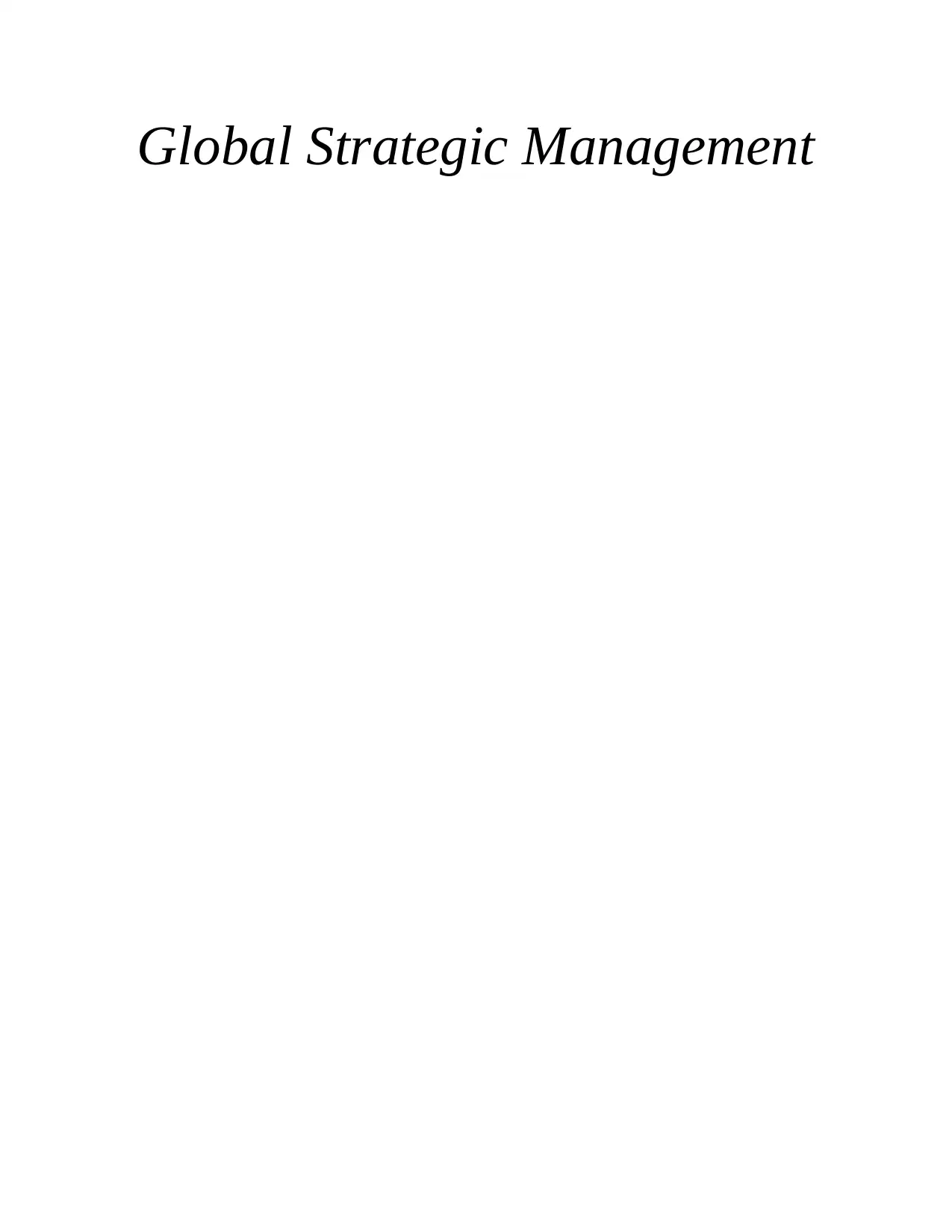
Global Strategic Management
Paraphrase This Document
Need a fresh take? Get an instant paraphrase of this document with our AI Paraphraser
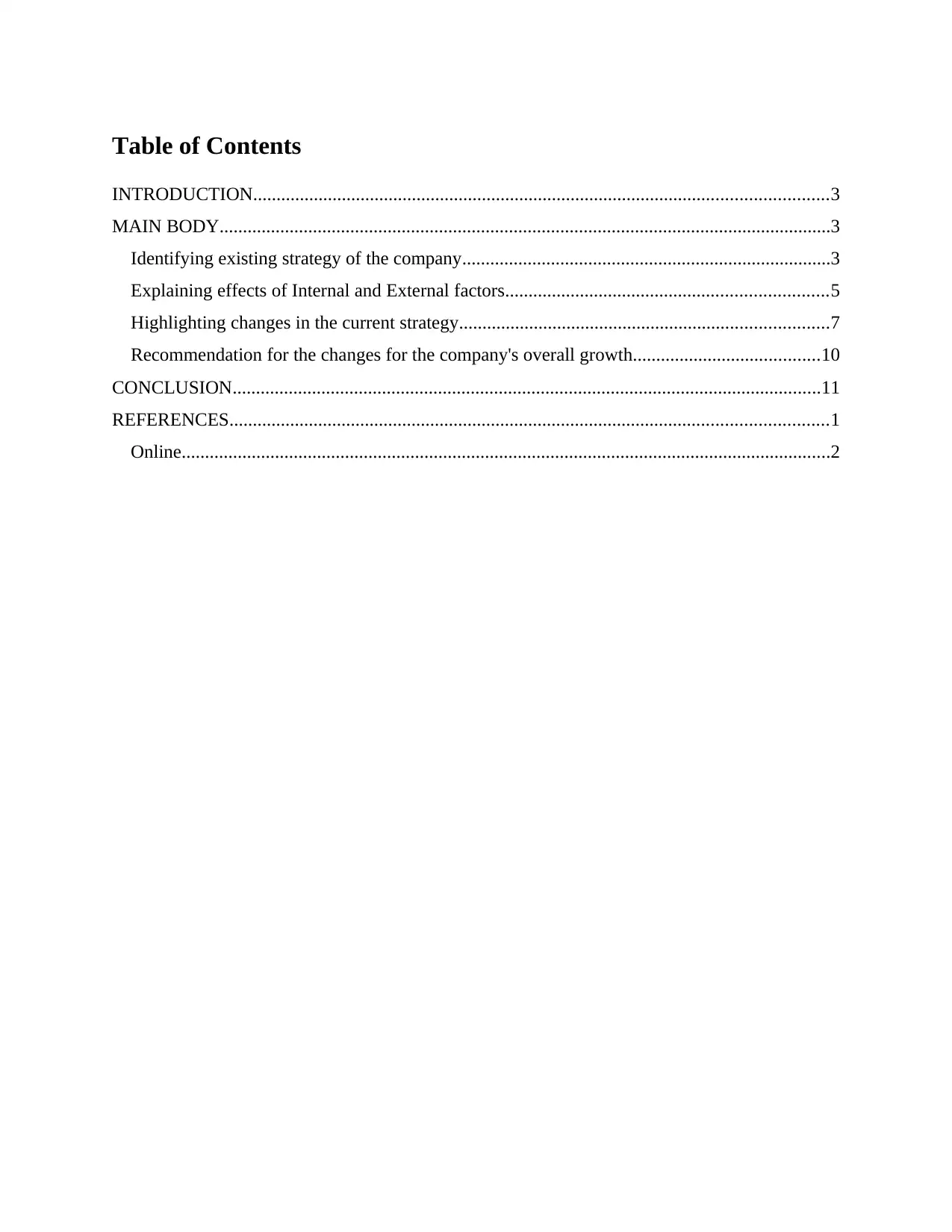
Table of Contents
INTRODUCTION...........................................................................................................................3
MAIN BODY...................................................................................................................................3
Identifying existing strategy of the company...............................................................................3
Explaining effects of Internal and External factors.....................................................................5
Highlighting changes in the current strategy...............................................................................7
Recommendation for the changes for the company's overall growth........................................10
CONCLUSION..............................................................................................................................11
REFERENCES................................................................................................................................1
Online...........................................................................................................................................2
INTRODUCTION...........................................................................................................................3
MAIN BODY...................................................................................................................................3
Identifying existing strategy of the company...............................................................................3
Explaining effects of Internal and External factors.....................................................................5
Highlighting changes in the current strategy...............................................................................7
Recommendation for the changes for the company's overall growth........................................10
CONCLUSION..............................................................................................................................11
REFERENCES................................................................................................................................1
Online...........................................................................................................................................2
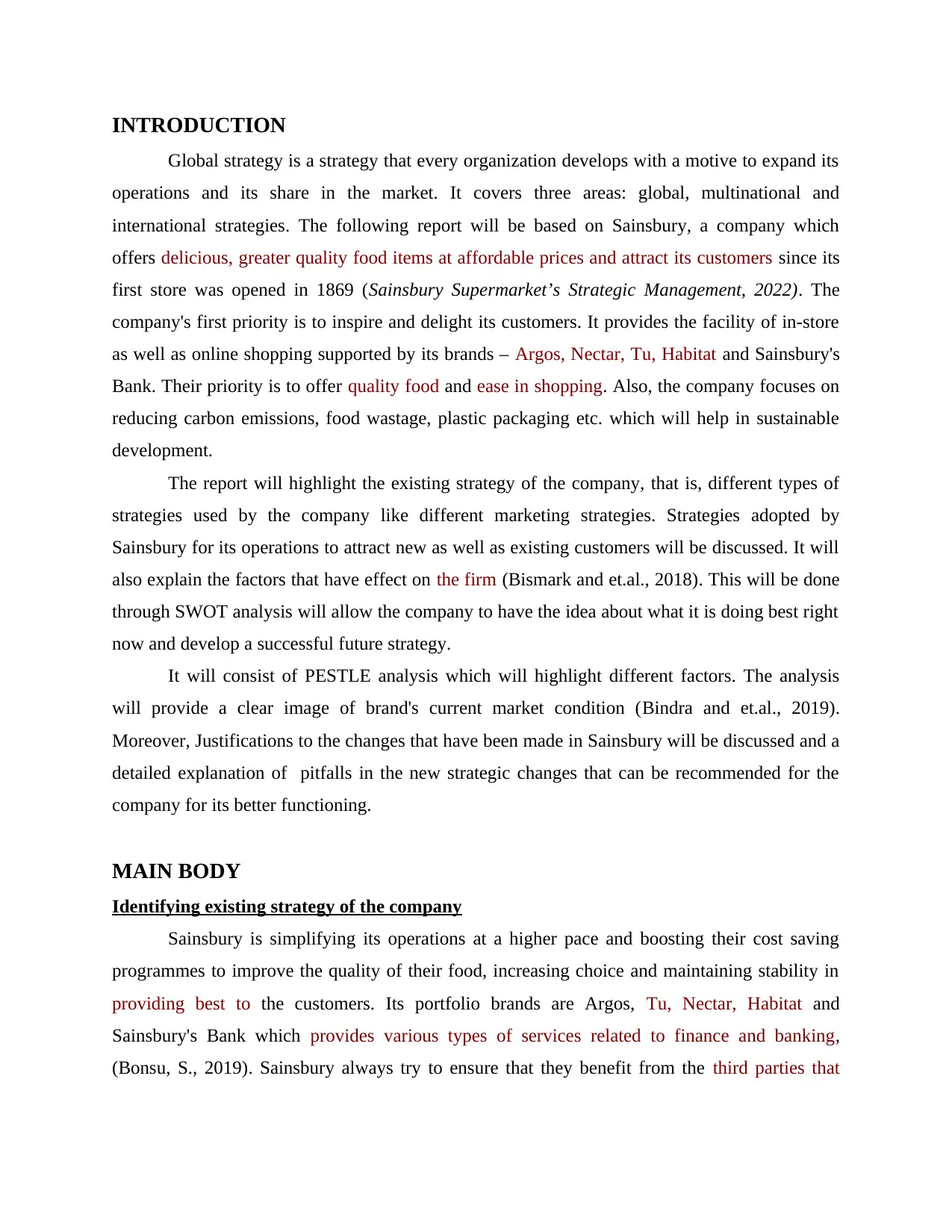
INTRODUCTION
Global strategy is a strategy that every organization develops with a motive to expand its
operations and its share in the market. It covers three areas: global, multinational and
international strategies. The following report will be based on Sainsbury, a company which
offers delicious, greater quality food items at affordable prices and attract its customers since its
first store was opened in 1869 (Sainsbury Supermarket’s Strategic Management, 2022). The
company's first priority is to inspire and delight its customers. It provides the facility of in-store
as well as online shopping supported by its brands – Argos, Nectar, Tu, Habitat and Sainsbury's
Bank. Their priority is to offer quality food and ease in shopping. Also, the company focuses on
reducing carbon emissions, food wastage, plastic packaging etc. which will help in sustainable
development.
The report will highlight the existing strategy of the company, that is, different types of
strategies used by the company like different marketing strategies. Strategies adopted by
Sainsbury for its operations to attract new as well as existing customers will be discussed. It will
also explain the factors that have effect on the firm (Bismark and et.al., 2018). This will be done
through SWOT analysis will allow the company to have the idea about what it is doing best right
now and develop a successful future strategy.
It will consist of PESTLE analysis which will highlight different factors. The analysis
will provide a clear image of brand's current market condition (Bindra and et.al., 2019).
Moreover, Justifications to the changes that have been made in Sainsbury will be discussed and a
detailed explanation of pitfalls in the new strategic changes that can be recommended for the
company for its better functioning.
MAIN BODY
Identifying existing strategy of the company
Sainsbury is simplifying its operations at a higher pace and boosting their cost saving
programmes to improve the quality of their food, increasing choice and maintaining stability in
providing best to the customers. Its portfolio brands are Argos, Tu, Nectar, Habitat and
Sainsbury's Bank which provides various types of services related to finance and banking,
(Bonsu, S., 2019). Sainsbury always try to ensure that they benefit from the third parties that
Global strategy is a strategy that every organization develops with a motive to expand its
operations and its share in the market. It covers three areas: global, multinational and
international strategies. The following report will be based on Sainsbury, a company which
offers delicious, greater quality food items at affordable prices and attract its customers since its
first store was opened in 1869 (Sainsbury Supermarket’s Strategic Management, 2022). The
company's first priority is to inspire and delight its customers. It provides the facility of in-store
as well as online shopping supported by its brands – Argos, Nectar, Tu, Habitat and Sainsbury's
Bank. Their priority is to offer quality food and ease in shopping. Also, the company focuses on
reducing carbon emissions, food wastage, plastic packaging etc. which will help in sustainable
development.
The report will highlight the existing strategy of the company, that is, different types of
strategies used by the company like different marketing strategies. Strategies adopted by
Sainsbury for its operations to attract new as well as existing customers will be discussed. It will
also explain the factors that have effect on the firm (Bismark and et.al., 2018). This will be done
through SWOT analysis will allow the company to have the idea about what it is doing best right
now and develop a successful future strategy.
It will consist of PESTLE analysis which will highlight different factors. The analysis
will provide a clear image of brand's current market condition (Bindra and et.al., 2019).
Moreover, Justifications to the changes that have been made in Sainsbury will be discussed and a
detailed explanation of pitfalls in the new strategic changes that can be recommended for the
company for its better functioning.
MAIN BODY
Identifying existing strategy of the company
Sainsbury is simplifying its operations at a higher pace and boosting their cost saving
programmes to improve the quality of their food, increasing choice and maintaining stability in
providing best to the customers. Its portfolio brands are Argos, Tu, Nectar, Habitat and
Sainsbury's Bank which provides various types of services related to finance and banking,
(Bonsu, S., 2019). Sainsbury always try to ensure that they benefit from the third parties that
⊘ This is a preview!⊘
Do you want full access?
Subscribe today to unlock all pages.

Trusted by 1+ million students worldwide
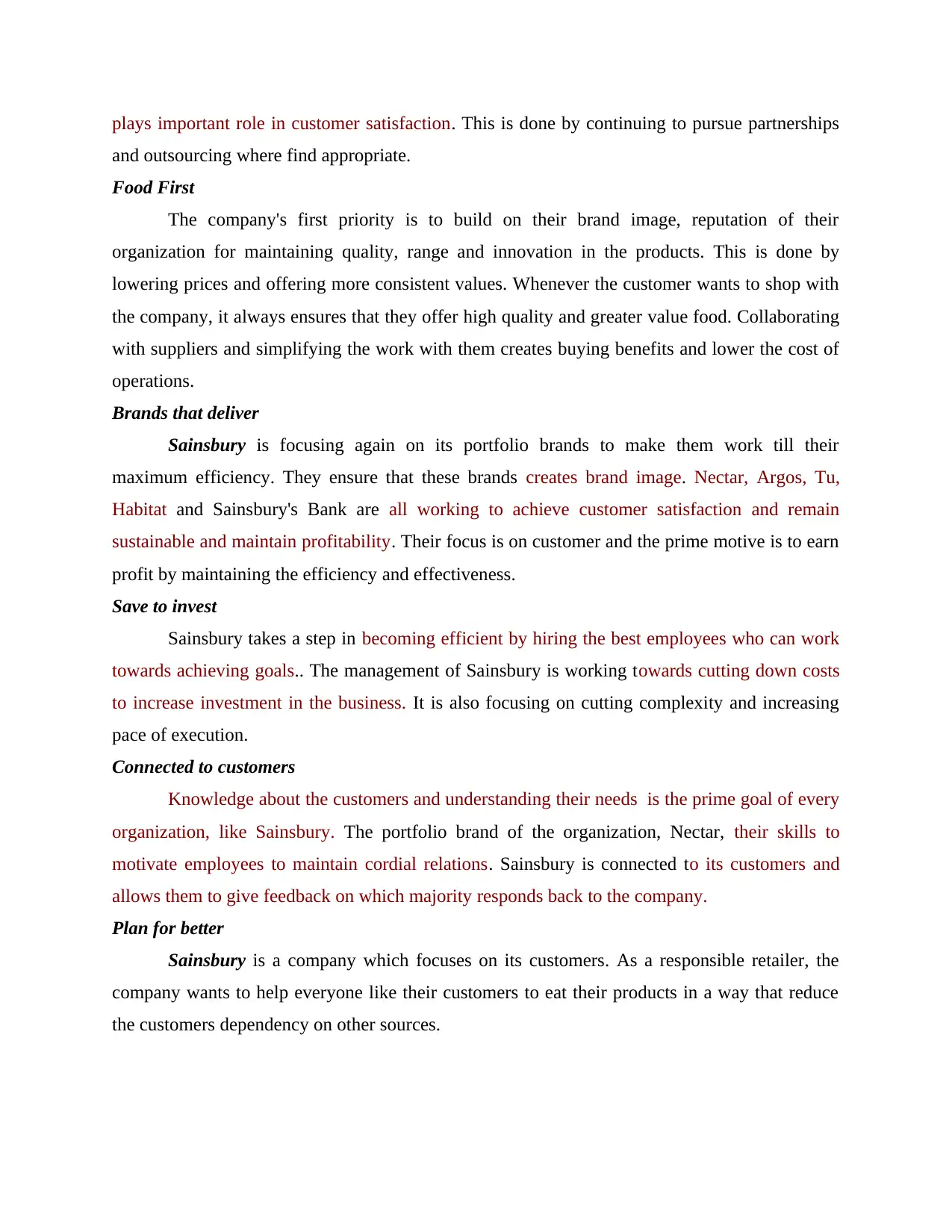
plays important role in customer satisfaction. This is done by continuing to pursue partnerships
and outsourcing where find appropriate.
Food First
The company's first priority is to build on their brand image, reputation of their
organization for maintaining quality, range and innovation in the products. This is done by
lowering prices and offering more consistent values. Whenever the customer wants to shop with
the company, it always ensures that they offer high quality and greater value food. Collaborating
with suppliers and simplifying the work with them creates buying benefits and lower the cost of
operations.
Brands that deliver
Sainsbury is focusing again on its portfolio brands to make them work till their
maximum efficiency. They ensure that these brands creates brand image. Nectar, Argos, Tu,
Habitat and Sainsbury's Bank are all working to achieve customer satisfaction and remain
sustainable and maintain profitability. Their focus is on customer and the prime motive is to earn
profit by maintaining the efficiency and effectiveness.
Save to invest
Sainsbury takes a step in becoming efficient by hiring the best employees who can work
towards achieving goals.. The management of Sainsbury is working towards cutting down costs
to increase investment in the business. It is also focusing on cutting complexity and increasing
pace of execution.
Connected to customers
Knowledge about the customers and understanding their needs is the prime goal of every
organization, like Sainsbury. The portfolio brand of the organization, Nectar, their skills to
motivate employees to maintain cordial relations. Sainsbury is connected to its customers and
allows them to give feedback on which majority responds back to the company.
Plan for better
Sainsbury is a company which focuses on its customers. As a responsible retailer, the
company wants to help everyone like their customers to eat their products in a way that reduce
the customers dependency on other sources.
and outsourcing where find appropriate.
Food First
The company's first priority is to build on their brand image, reputation of their
organization for maintaining quality, range and innovation in the products. This is done by
lowering prices and offering more consistent values. Whenever the customer wants to shop with
the company, it always ensures that they offer high quality and greater value food. Collaborating
with suppliers and simplifying the work with them creates buying benefits and lower the cost of
operations.
Brands that deliver
Sainsbury is focusing again on its portfolio brands to make them work till their
maximum efficiency. They ensure that these brands creates brand image. Nectar, Argos, Tu,
Habitat and Sainsbury's Bank are all working to achieve customer satisfaction and remain
sustainable and maintain profitability. Their focus is on customer and the prime motive is to earn
profit by maintaining the efficiency and effectiveness.
Save to invest
Sainsbury takes a step in becoming efficient by hiring the best employees who can work
towards achieving goals.. The management of Sainsbury is working towards cutting down costs
to increase investment in the business. It is also focusing on cutting complexity and increasing
pace of execution.
Connected to customers
Knowledge about the customers and understanding their needs is the prime goal of every
organization, like Sainsbury. The portfolio brand of the organization, Nectar, their skills to
motivate employees to maintain cordial relations. Sainsbury is connected to its customers and
allows them to give feedback on which majority responds back to the company.
Plan for better
Sainsbury is a company which focuses on its customers. As a responsible retailer, the
company wants to help everyone like their customers to eat their products in a way that reduce
the customers dependency on other sources.
Paraphrase This Document
Need a fresh take? Get an instant paraphrase of this document with our AI Paraphraser
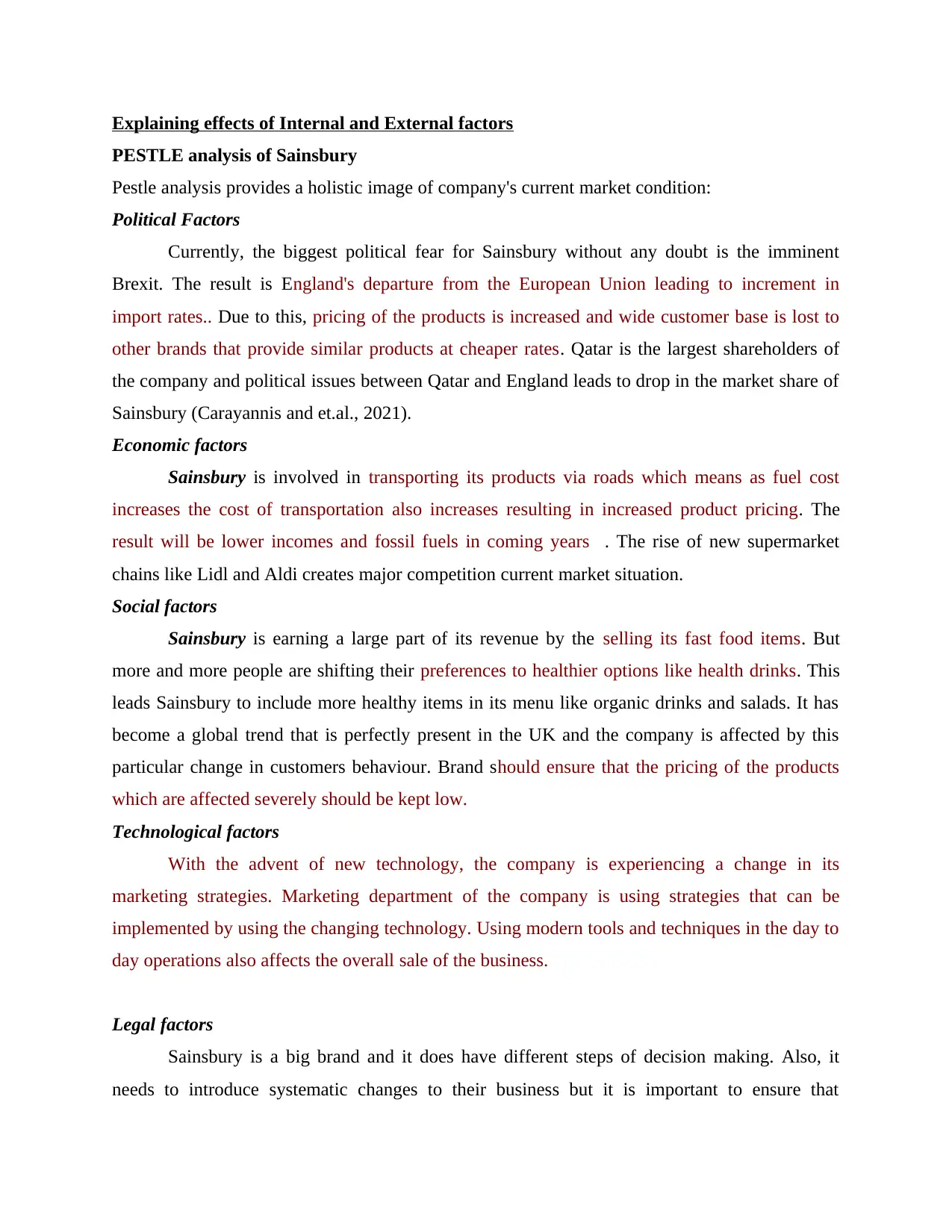
Explaining effects of Internal and External factors
PESTLE analysis of Sainsbury
Pestle analysis provides a holistic image of company's current market condition:
Political Factors
Currently, the biggest political fear for Sainsbury without any doubt is the imminent
Brexit. The result is England's departure from the European Union leading to increment in
import rates.. Due to this, pricing of the products is increased and wide customer base is lost to
other brands that provide similar products at cheaper rates. Qatar is the largest shareholders of
the company and political issues between Qatar and England leads to drop in the market share of
Sainsbury (Carayannis and et.al., 2021).
Economic factors
Sainsbury is involved in transporting its products via roads which means as fuel cost
increases the cost of transportation also increases resulting in increased product pricing. The
result will be lower incomes and fossil fuels in coming years . The rise of new supermarket
chains like Lidl and Aldi creates major competition current market situation.
Social factors
Sainsbury is earning a large part of its revenue by the selling its fast food items. But
more and more people are shifting their preferences to healthier options like health drinks. This
leads Sainsbury to include more healthy items in its menu like organic drinks and salads. It has
become a global trend that is perfectly present in the UK and the company is affected by this
particular change in customers behaviour. Brand should ensure that the pricing of the products
which are affected severely should be kept low.
Technological factors
With the advent of new technology, the company is experiencing a change in its
marketing strategies. Marketing department of the company is using strategies that can be
implemented by using the changing technology. Using modern tools and techniques in the day to
day operations also affects the overall sale of the business.
Legal factors
Sainsbury is a big brand and it does have different steps of decision making. Also, it
needs to introduce systematic changes to their business but it is important to ensure that
PESTLE analysis of Sainsbury
Pestle analysis provides a holistic image of company's current market condition:
Political Factors
Currently, the biggest political fear for Sainsbury without any doubt is the imminent
Brexit. The result is England's departure from the European Union leading to increment in
import rates.. Due to this, pricing of the products is increased and wide customer base is lost to
other brands that provide similar products at cheaper rates. Qatar is the largest shareholders of
the company and political issues between Qatar and England leads to drop in the market share of
Sainsbury (Carayannis and et.al., 2021).
Economic factors
Sainsbury is involved in transporting its products via roads which means as fuel cost
increases the cost of transportation also increases resulting in increased product pricing. The
result will be lower incomes and fossil fuels in coming years . The rise of new supermarket
chains like Lidl and Aldi creates major competition current market situation.
Social factors
Sainsbury is earning a large part of its revenue by the selling its fast food items. But
more and more people are shifting their preferences to healthier options like health drinks. This
leads Sainsbury to include more healthy items in its menu like organic drinks and salads. It has
become a global trend that is perfectly present in the UK and the company is affected by this
particular change in customers behaviour. Brand should ensure that the pricing of the products
which are affected severely should be kept low.
Technological factors
With the advent of new technology, the company is experiencing a change in its
marketing strategies. Marketing department of the company is using strategies that can be
implemented by using the changing technology. Using modern tools and techniques in the day to
day operations also affects the overall sale of the business.
Legal factors
Sainsbury is a big brand and it does have different steps of decision making. Also, it
needs to introduce systematic changes to their business but it is important to ensure that
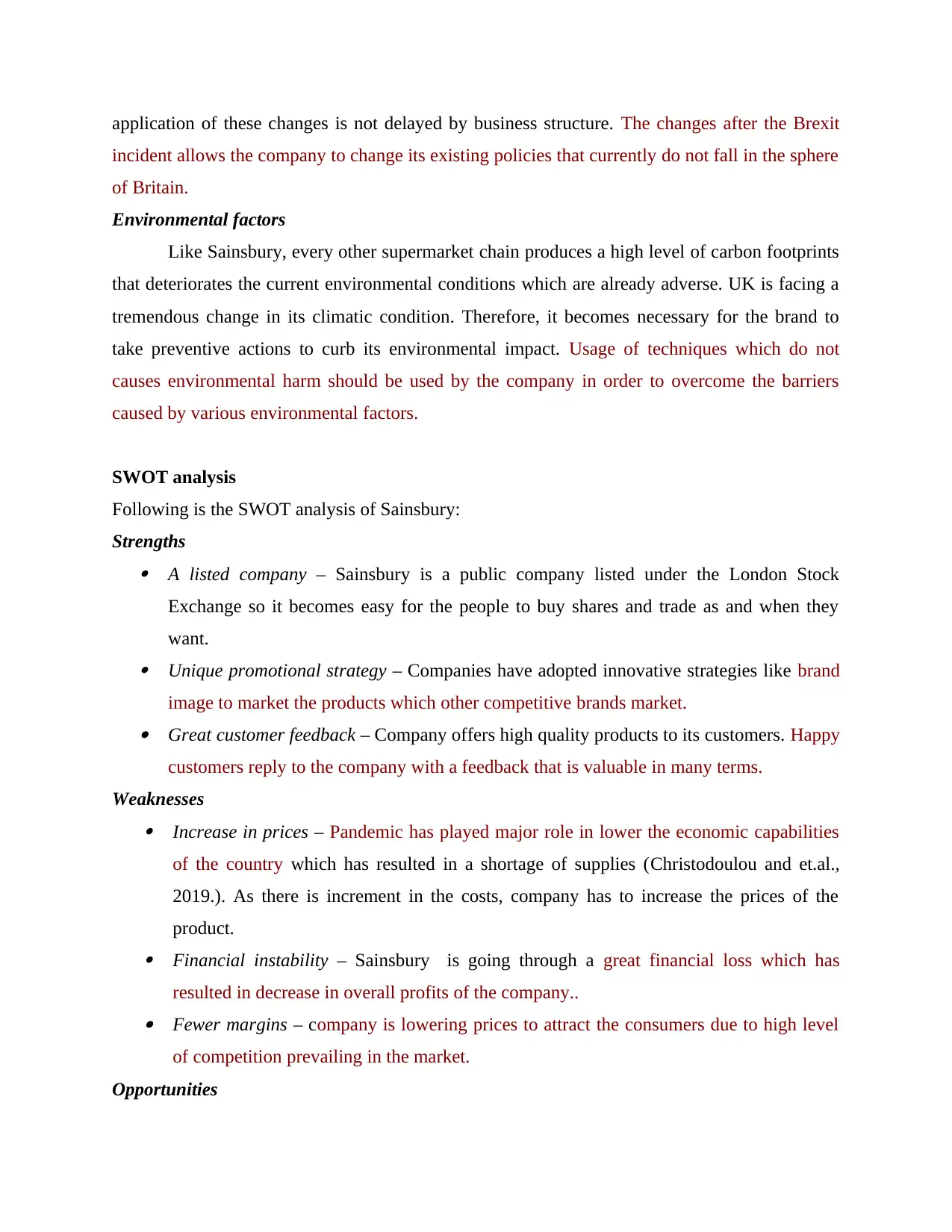
application of these changes is not delayed by business structure. The changes after the Brexit
incident allows the company to change its existing policies that currently do not fall in the sphere
of Britain.
Environmental factors
Like Sainsbury, every other supermarket chain produces a high level of carbon footprints
that deteriorates the current environmental conditions which are already adverse. UK is facing a
tremendous change in its climatic condition. Therefore, it becomes necessary for the brand to
take preventive actions to curb its environmental impact. Usage of techniques which do not
causes environmental harm should be used by the company in order to overcome the barriers
caused by various environmental factors.
SWOT analysis
Following is the SWOT analysis of Sainsbury:
Strengths A listed company – Sainsbury is a public company listed under the London Stock
Exchange so it becomes easy for the people to buy shares and trade as and when they
want. Unique promotional strategy – Companies have adopted innovative strategies like brand
image to market the products which other competitive brands market. Great customer feedback – Company offers high quality products to its customers. Happy
customers reply to the company with a feedback that is valuable in many terms.
Weaknesses Increase in prices – Pandemic has played major role in lower the economic capabilities
of the country which has resulted in a shortage of supplies (Christodoulou and et.al.,
2019.). As there is increment in the costs, company has to increase the prices of the
product. Financial instability – Sainsbury is going through a great financial loss which has
resulted in decrease in overall profits of the company.. Fewer margins – company is lowering prices to attract the consumers due to high level
of competition prevailing in the market.
Opportunities
incident allows the company to change its existing policies that currently do not fall in the sphere
of Britain.
Environmental factors
Like Sainsbury, every other supermarket chain produces a high level of carbon footprints
that deteriorates the current environmental conditions which are already adverse. UK is facing a
tremendous change in its climatic condition. Therefore, it becomes necessary for the brand to
take preventive actions to curb its environmental impact. Usage of techniques which do not
causes environmental harm should be used by the company in order to overcome the barriers
caused by various environmental factors.
SWOT analysis
Following is the SWOT analysis of Sainsbury:
Strengths A listed company – Sainsbury is a public company listed under the London Stock
Exchange so it becomes easy for the people to buy shares and trade as and when they
want. Unique promotional strategy – Companies have adopted innovative strategies like brand
image to market the products which other competitive brands market. Great customer feedback – Company offers high quality products to its customers. Happy
customers reply to the company with a feedback that is valuable in many terms.
Weaknesses Increase in prices – Pandemic has played major role in lower the economic capabilities
of the country which has resulted in a shortage of supplies (Christodoulou and et.al.,
2019.). As there is increment in the costs, company has to increase the prices of the
product. Financial instability – Sainsbury is going through a great financial loss which has
resulted in decrease in overall profits of the company.. Fewer margins – company is lowering prices to attract the consumers due to high level
of competition prevailing in the market.
Opportunities
⊘ This is a preview!⊘
Do you want full access?
Subscribe today to unlock all pages.

Trusted by 1+ million students worldwide
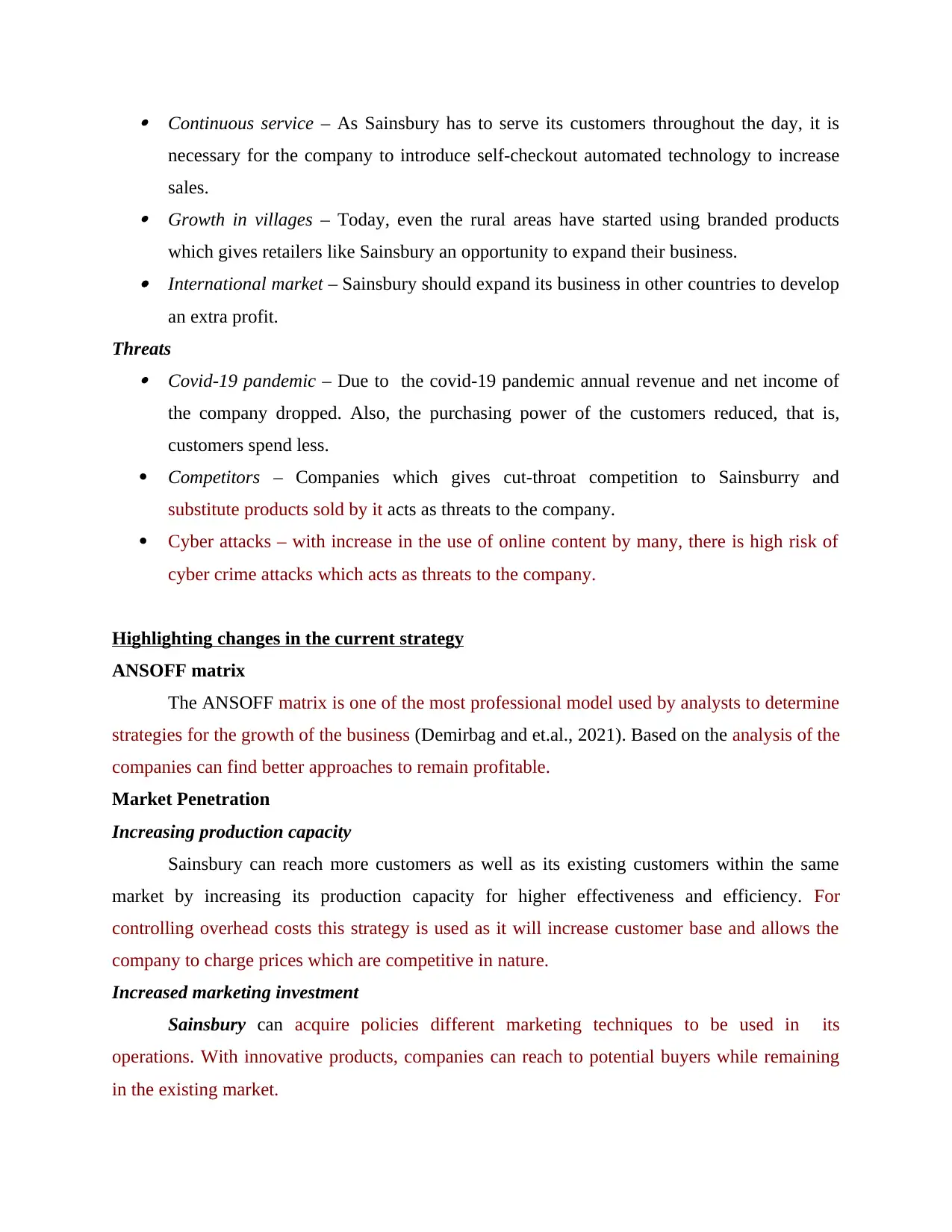
Continuous service – As Sainsbury has to serve its customers throughout the day, it is
necessary for the company to introduce self-checkout automated technology to increase
sales. Growth in villages – Today, even the rural areas have started using branded products
which gives retailers like Sainsbury an opportunity to expand their business. International market – Sainsbury should expand its business in other countries to develop
an extra profit.
Threats Covid-19 pandemic – Due to the covid-19 pandemic annual revenue and net income of
the company dropped. Also, the purchasing power of the customers reduced, that is,
customers spend less.
Competitors – Companies which gives cut-throat competition to Sainsburry and
substitute products sold by it acts as threats to the company.
Cyber attacks – with increase in the use of online content by many, there is high risk of
cyber crime attacks which acts as threats to the company.
Highlighting changes in the current strategy
ANSOFF matrix
The ANSOFF matrix is one of the most professional model used by analysts to determine
strategies for the growth of the business (Demirbag and et.al., 2021). Based on the analysis of the
companies can find better approaches to remain profitable.
Market Penetration
Increasing production capacity
Sainsbury can reach more customers as well as its existing customers within the same
market by increasing its production capacity for higher effectiveness and efficiency. For
controlling overhead costs this strategy is used as it will increase customer base and allows the
company to charge prices which are competitive in nature.
Increased marketing investment
Sainsbury can acquire policies different marketing techniques to be used in its
operations. With innovative products, companies can reach to potential buyers while remaining
in the existing market.
necessary for the company to introduce self-checkout automated technology to increase
sales. Growth in villages – Today, even the rural areas have started using branded products
which gives retailers like Sainsbury an opportunity to expand their business. International market – Sainsbury should expand its business in other countries to develop
an extra profit.
Threats Covid-19 pandemic – Due to the covid-19 pandemic annual revenue and net income of
the company dropped. Also, the purchasing power of the customers reduced, that is,
customers spend less.
Competitors – Companies which gives cut-throat competition to Sainsburry and
substitute products sold by it acts as threats to the company.
Cyber attacks – with increase in the use of online content by many, there is high risk of
cyber crime attacks which acts as threats to the company.
Highlighting changes in the current strategy
ANSOFF matrix
The ANSOFF matrix is one of the most professional model used by analysts to determine
strategies for the growth of the business (Demirbag and et.al., 2021). Based on the analysis of the
companies can find better approaches to remain profitable.
Market Penetration
Increasing production capacity
Sainsbury can reach more customers as well as its existing customers within the same
market by increasing its production capacity for higher effectiveness and efficiency. For
controlling overhead costs this strategy is used as it will increase customer base and allows the
company to charge prices which are competitive in nature.
Increased marketing investment
Sainsbury can acquire policies different marketing techniques to be used in its
operations. With innovative products, companies can reach to potential buyers while remaining
in the existing market.
Paraphrase This Document
Need a fresh take? Get an instant paraphrase of this document with our AI Paraphraser
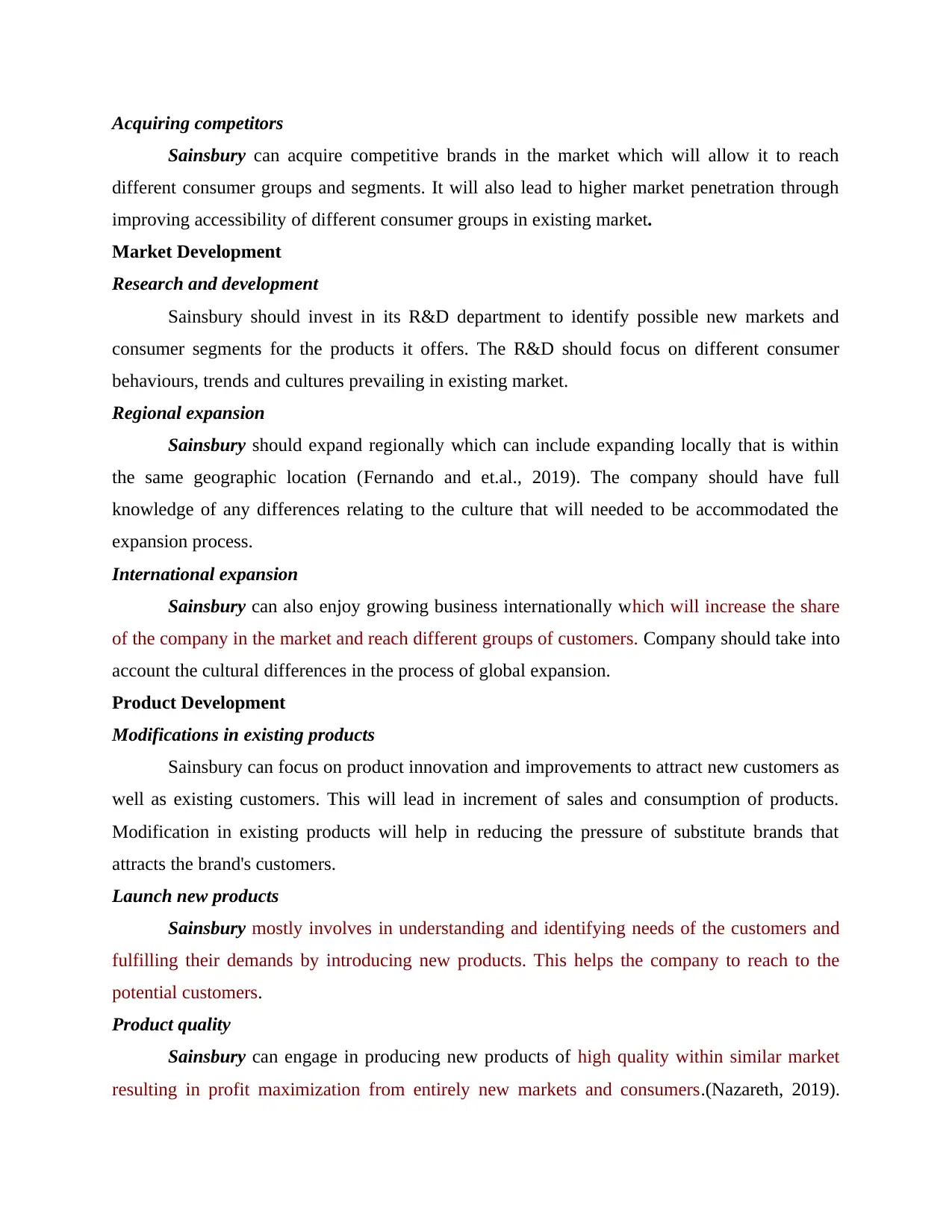
Acquiring competitors
Sainsbury can acquire competitive brands in the market which will allow it to reach
different consumer groups and segments. It will also lead to higher market penetration through
improving accessibility of different consumer groups in existing market.
Market Development
Research and development
Sainsbury should invest in its R&D department to identify possible new markets and
consumer segments for the products it offers. The R&D should focus on different consumer
behaviours, trends and cultures prevailing in existing market.
Regional expansion
Sainsbury should expand regionally which can include expanding locally that is within
the same geographic location (Fernando and et.al., 2019). The company should have full
knowledge of any differences relating to the culture that will needed to be accommodated the
expansion process.
International expansion
Sainsbury can also enjoy growing business internationally which will increase the share
of the company in the market and reach different groups of customers. Company should take into
account the cultural differences in the process of global expansion.
Product Development
Modifications in existing products
Sainsbury can focus on product innovation and improvements to attract new customers as
well as existing customers. This will lead in increment of sales and consumption of products.
Modification in existing products will help in reducing the pressure of substitute brands that
attracts the brand's customers.
Launch new products
Sainsbury mostly involves in understanding and identifying needs of the customers and
fulfilling their demands by introducing new products. This helps the company to reach to the
potential customers.
Product quality
Sainsbury can engage in producing new products of high quality within similar market
resulting in profit maximization from entirely new markets and consumers.(Nazareth, 2019).
Sainsbury can acquire competitive brands in the market which will allow it to reach
different consumer groups and segments. It will also lead to higher market penetration through
improving accessibility of different consumer groups in existing market.
Market Development
Research and development
Sainsbury should invest in its R&D department to identify possible new markets and
consumer segments for the products it offers. The R&D should focus on different consumer
behaviours, trends and cultures prevailing in existing market.
Regional expansion
Sainsbury should expand regionally which can include expanding locally that is within
the same geographic location (Fernando and et.al., 2019). The company should have full
knowledge of any differences relating to the culture that will needed to be accommodated the
expansion process.
International expansion
Sainsbury can also enjoy growing business internationally which will increase the share
of the company in the market and reach different groups of customers. Company should take into
account the cultural differences in the process of global expansion.
Product Development
Modifications in existing products
Sainsbury can focus on product innovation and improvements to attract new customers as
well as existing customers. This will lead in increment of sales and consumption of products.
Modification in existing products will help in reducing the pressure of substitute brands that
attracts the brand's customers.
Launch new products
Sainsbury mostly involves in understanding and identifying needs of the customers and
fulfilling their demands by introducing new products. This helps the company to reach to the
potential customers.
Product quality
Sainsbury can engage in producing new products of high quality within similar market
resulting in profit maximization from entirely new markets and consumers.(Nazareth, 2019).
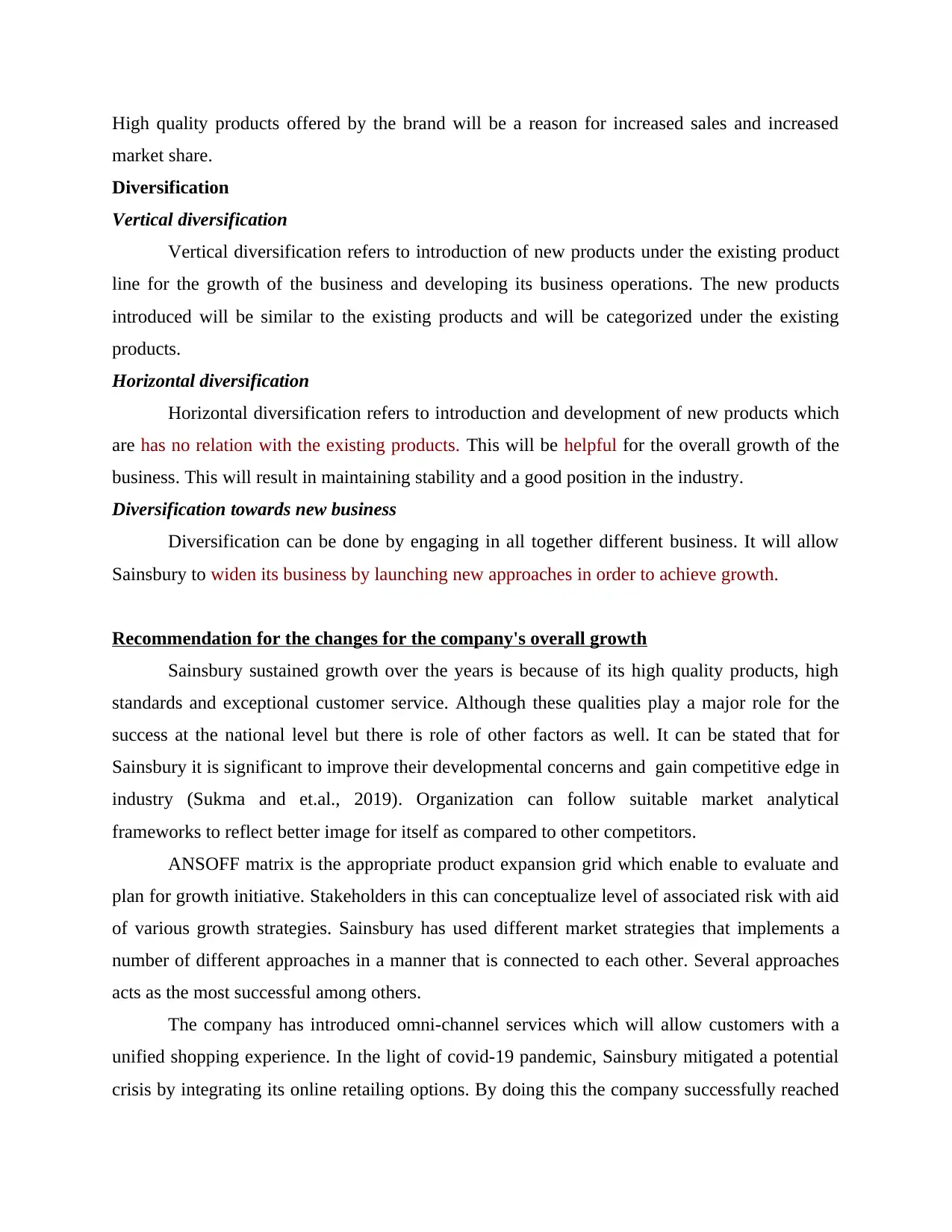
High quality products offered by the brand will be a reason for increased sales and increased
market share.
Diversification
Vertical diversification
Vertical diversification refers to introduction of new products under the existing product
line for the growth of the business and developing its business operations. The new products
introduced will be similar to the existing products and will be categorized under the existing
products.
Horizontal diversification
Horizontal diversification refers to introduction and development of new products which
are has no relation with the existing products. This will be helpful for the overall growth of the
business. This will result in maintaining stability and a good position in the industry.
Diversification towards new business
Diversification can be done by engaging in all together different business. It will allow
Sainsbury to widen its business by launching new approaches in order to achieve growth.
Recommendation for the changes for the company's overall growth
Sainsbury sustained growth over the years is because of its high quality products, high
standards and exceptional customer service. Although these qualities play a major role for the
success at the national level but there is role of other factors as well. It can be stated that for
Sainsbury it is significant to improve their developmental concerns and gain competitive edge in
industry (Sukma and et.al., 2019). Organization can follow suitable market analytical
frameworks to reflect better image for itself as compared to other competitors.
ANSOFF matrix is the appropriate product expansion grid which enable to evaluate and
plan for growth initiative. Stakeholders in this can conceptualize level of associated risk with aid
of various growth strategies. Sainsbury has used different market strategies that implements a
number of different approaches in a manner that is connected to each other. Several approaches
acts as the most successful among others.
The company has introduced omni-channel services which will allow customers with a
unified shopping experience. In the light of covid-19 pandemic, Sainsbury mitigated a potential
crisis by integrating its online retailing options. By doing this the company successfully reached
market share.
Diversification
Vertical diversification
Vertical diversification refers to introduction of new products under the existing product
line for the growth of the business and developing its business operations. The new products
introduced will be similar to the existing products and will be categorized under the existing
products.
Horizontal diversification
Horizontal diversification refers to introduction and development of new products which
are has no relation with the existing products. This will be helpful for the overall growth of the
business. This will result in maintaining stability and a good position in the industry.
Diversification towards new business
Diversification can be done by engaging in all together different business. It will allow
Sainsbury to widen its business by launching new approaches in order to achieve growth.
Recommendation for the changes for the company's overall growth
Sainsbury sustained growth over the years is because of its high quality products, high
standards and exceptional customer service. Although these qualities play a major role for the
success at the national level but there is role of other factors as well. It can be stated that for
Sainsbury it is significant to improve their developmental concerns and gain competitive edge in
industry (Sukma and et.al., 2019). Organization can follow suitable market analytical
frameworks to reflect better image for itself as compared to other competitors.
ANSOFF matrix is the appropriate product expansion grid which enable to evaluate and
plan for growth initiative. Stakeholders in this can conceptualize level of associated risk with aid
of various growth strategies. Sainsbury has used different market strategies that implements a
number of different approaches in a manner that is connected to each other. Several approaches
acts as the most successful among others.
The company has introduced omni-channel services which will allow customers with a
unified shopping experience. In the light of covid-19 pandemic, Sainsbury mitigated a potential
crisis by integrating its online retailing options. By doing this the company successfully reached
⊘ This is a preview!⊘
Do you want full access?
Subscribe today to unlock all pages.

Trusted by 1+ million students worldwide
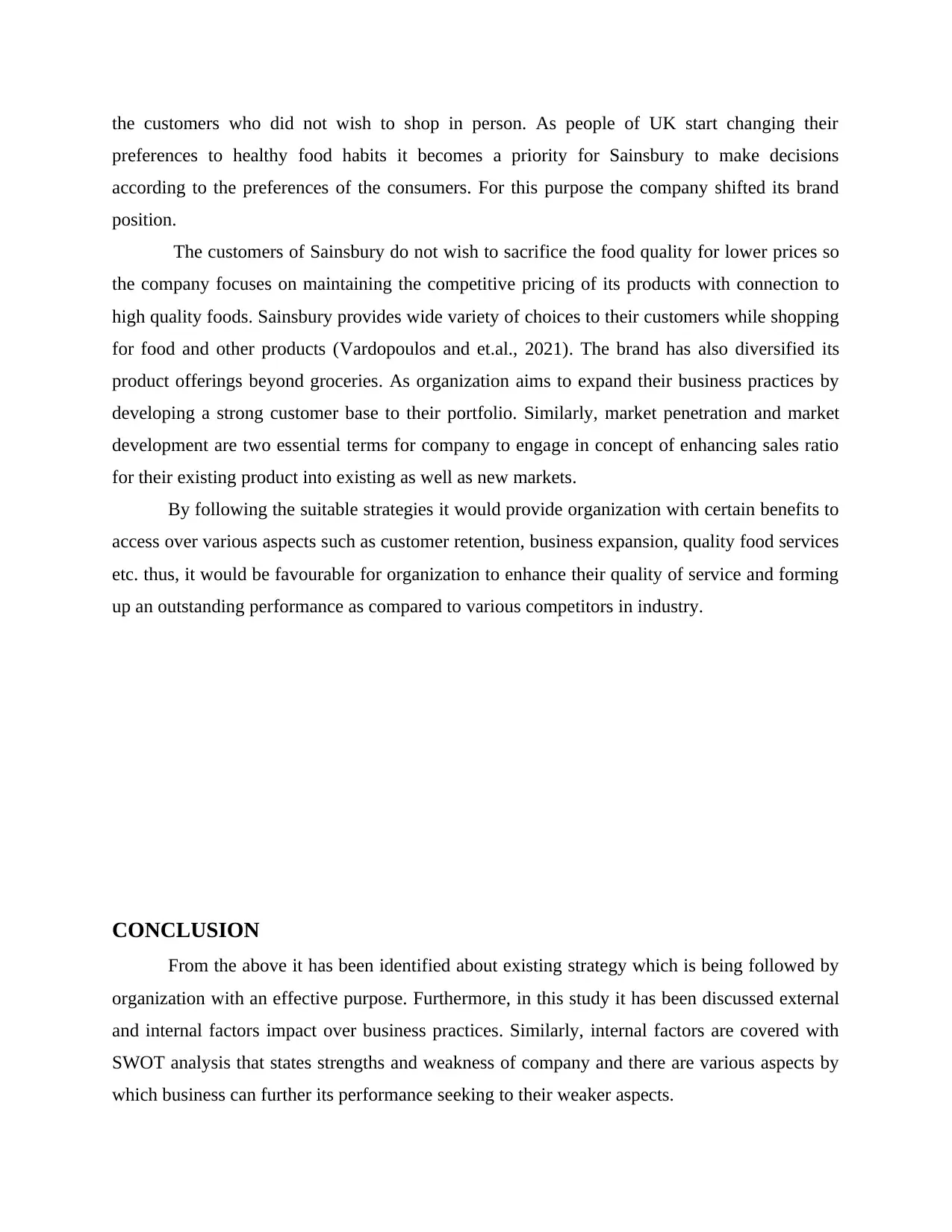
the customers who did not wish to shop in person. As people of UK start changing their
preferences to healthy food habits it becomes a priority for Sainsbury to make decisions
according to the preferences of the consumers. For this purpose the company shifted its brand
position.
The customers of Sainsbury do not wish to sacrifice the food quality for lower prices so
the company focuses on maintaining the competitive pricing of its products with connection to
high quality foods. Sainsbury provides wide variety of choices to their customers while shopping
for food and other products (Vardopoulos and et.al., 2021). The brand has also diversified its
product offerings beyond groceries. As organization aims to expand their business practices by
developing a strong customer base to their portfolio. Similarly, market penetration and market
development are two essential terms for company to engage in concept of enhancing sales ratio
for their existing product into existing as well as new markets.
By following the suitable strategies it would provide organization with certain benefits to
access over various aspects such as customer retention, business expansion, quality food services
etc. thus, it would be favourable for organization to enhance their quality of service and forming
up an outstanding performance as compared to various competitors in industry.
CONCLUSION
From the above it has been identified about existing strategy which is being followed by
organization with an effective purpose. Furthermore, in this study it has been discussed external
and internal factors impact over business practices. Similarly, internal factors are covered with
SWOT analysis that states strengths and weakness of company and there are various aspects by
which business can further its performance seeking to their weaker aspects.
preferences to healthy food habits it becomes a priority for Sainsbury to make decisions
according to the preferences of the consumers. For this purpose the company shifted its brand
position.
The customers of Sainsbury do not wish to sacrifice the food quality for lower prices so
the company focuses on maintaining the competitive pricing of its products with connection to
high quality foods. Sainsbury provides wide variety of choices to their customers while shopping
for food and other products (Vardopoulos and et.al., 2021). The brand has also diversified its
product offerings beyond groceries. As organization aims to expand their business practices by
developing a strong customer base to their portfolio. Similarly, market penetration and market
development are two essential terms for company to engage in concept of enhancing sales ratio
for their existing product into existing as well as new markets.
By following the suitable strategies it would provide organization with certain benefits to
access over various aspects such as customer retention, business expansion, quality food services
etc. thus, it would be favourable for organization to enhance their quality of service and forming
up an outstanding performance as compared to various competitors in industry.
CONCLUSION
From the above it has been identified about existing strategy which is being followed by
organization with an effective purpose. Furthermore, in this study it has been discussed external
and internal factors impact over business practices. Similarly, internal factors are covered with
SWOT analysis that states strengths and weakness of company and there are various aspects by
which business can further its performance seeking to their weaker aspects.
Paraphrase This Document
Need a fresh take? Get an instant paraphrase of this document with our AI Paraphraser
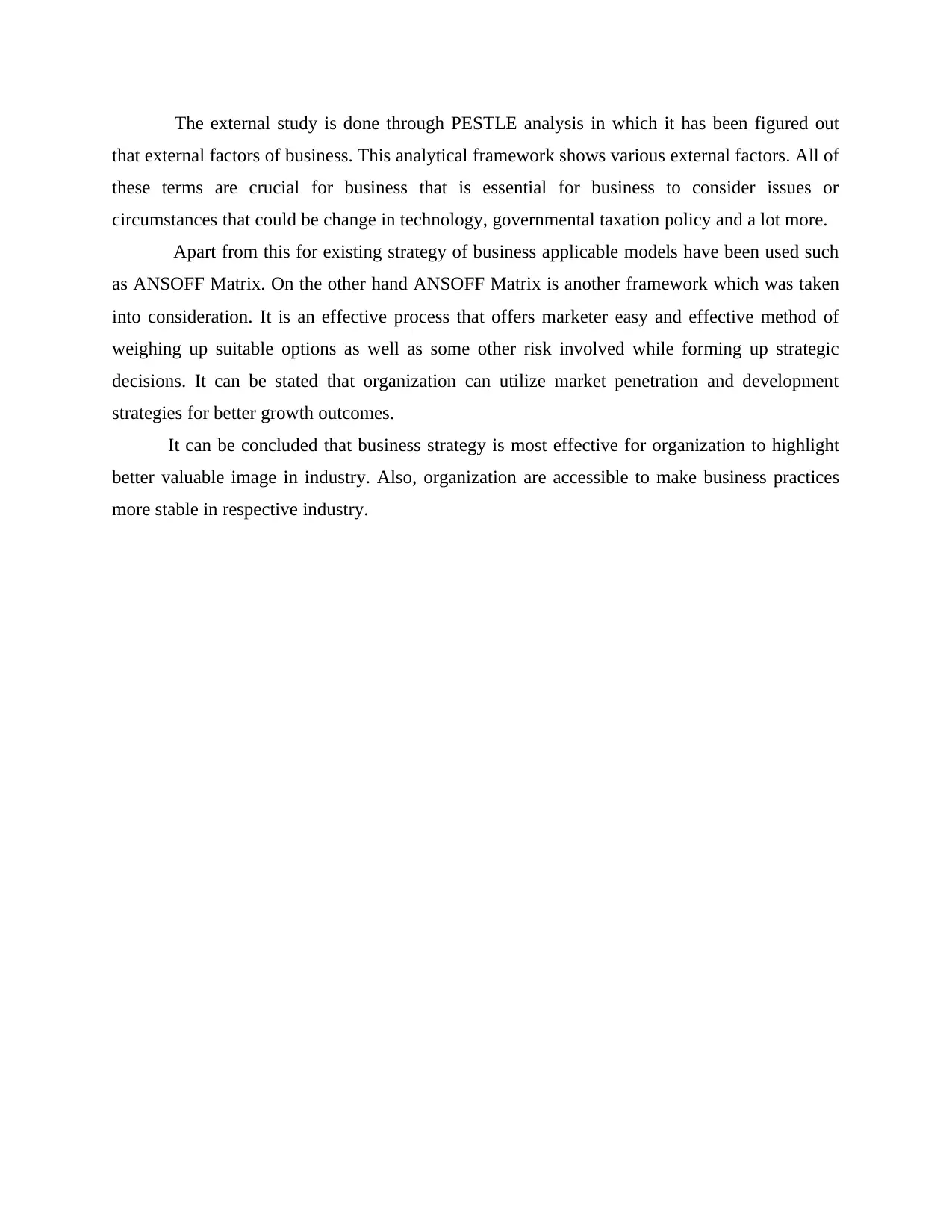
The external study is done through PESTLE analysis in which it has been figured out
that external factors of business. This analytical framework shows various external factors. All of
these terms are crucial for business that is essential for business to consider issues or
circumstances that could be change in technology, governmental taxation policy and a lot more.
Apart from this for existing strategy of business applicable models have been used such
as ANSOFF Matrix. On the other hand ANSOFF Matrix is another framework which was taken
into consideration. It is an effective process that offers marketer easy and effective method of
weighing up suitable options as well as some other risk involved while forming up strategic
decisions. It can be stated that organization can utilize market penetration and development
strategies for better growth outcomes.
It can be concluded that business strategy is most effective for organization to highlight
better valuable image in industry. Also, organization are accessible to make business practices
more stable in respective industry.
that external factors of business. This analytical framework shows various external factors. All of
these terms are crucial for business that is essential for business to consider issues or
circumstances that could be change in technology, governmental taxation policy and a lot more.
Apart from this for existing strategy of business applicable models have been used such
as ANSOFF Matrix. On the other hand ANSOFF Matrix is another framework which was taken
into consideration. It is an effective process that offers marketer easy and effective method of
weighing up suitable options as well as some other risk involved while forming up strategic
decisions. It can be stated that organization can utilize market penetration and development
strategies for better growth outcomes.
It can be concluded that business strategy is most effective for organization to highlight
better valuable image in industry. Also, organization are accessible to make business practices
more stable in respective industry.
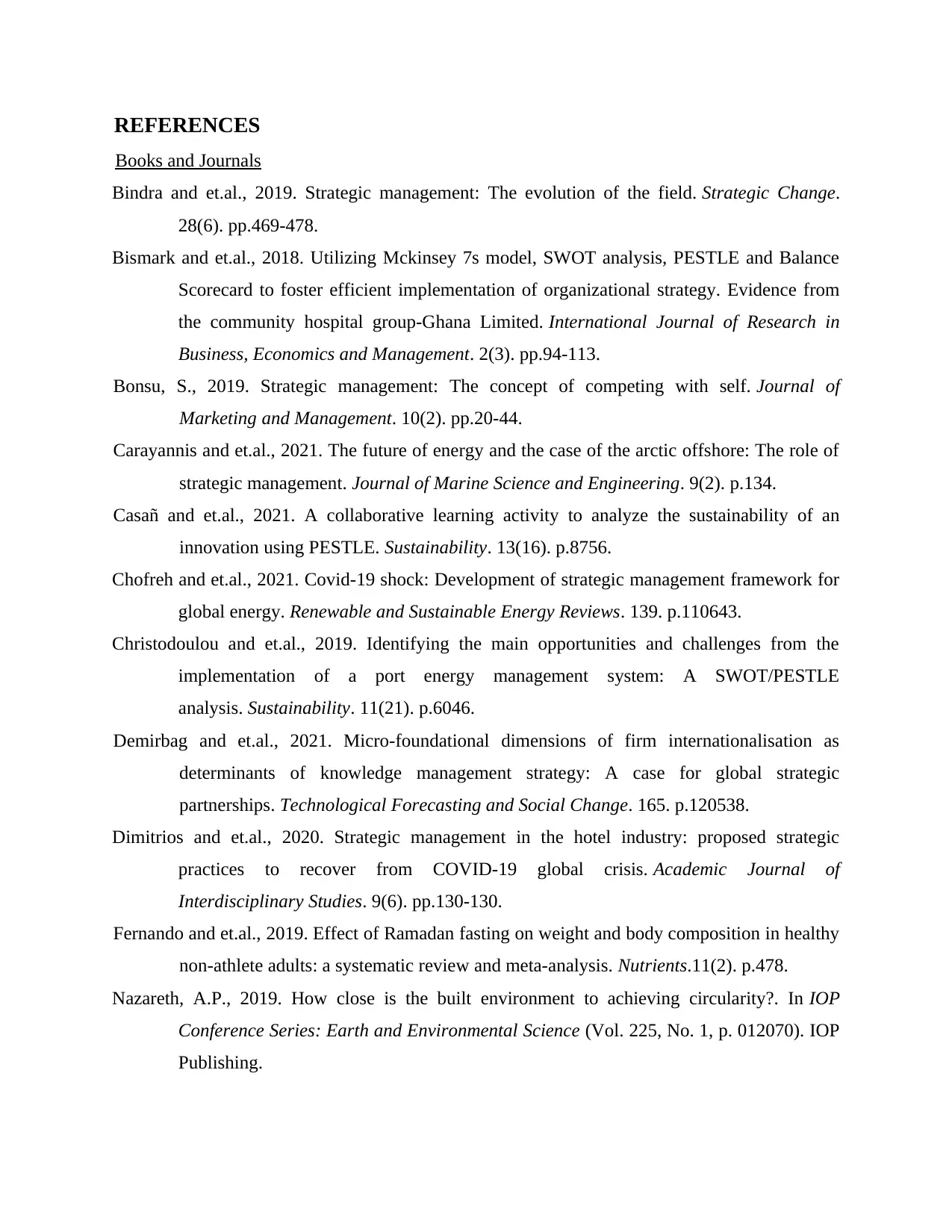
REFERENCES
Books and Journals
Bindra and et.al., 2019. Strategic management: The evolution of the field. Strategic Change.
28(6). pp.469-478.
Bismark and et.al., 2018. Utilizing Mckinsey 7s model, SWOT analysis, PESTLE and Balance
Scorecard to foster efficient implementation of organizational strategy. Evidence from
the community hospital group-Ghana Limited. International Journal of Research in
Business, Economics and Management. 2(3). pp.94-113.
Bonsu, S., 2019. Strategic management: The concept of competing with self. Journal of
Marketing and Management. 10(2). pp.20-44.
Carayannis and et.al., 2021. The future of energy and the case of the arctic offshore: The role of
strategic management. Journal of Marine Science and Engineering. 9(2). p.134.
Casañ and et.al., 2021. A collaborative learning activity to analyze the sustainability of an
innovation using PESTLE. Sustainability. 13(16). p.8756.
Chofreh and et.al., 2021. Covid-19 shock: Development of strategic management framework for
global energy. Renewable and Sustainable Energy Reviews. 139. p.110643.
Christodoulou and et.al., 2019. Identifying the main opportunities and challenges from the
implementation of a port energy management system: A SWOT/PESTLE
analysis. Sustainability. 11(21). p.6046.
Demirbag and et.al., 2021. Micro-foundational dimensions of firm internationalisation as
determinants of knowledge management strategy: A case for global strategic
partnerships. Technological Forecasting and Social Change. 165. p.120538.
Dimitrios and et.al., 2020. Strategic management in the hotel industry: proposed strategic
practices to recover from COVID-19 global crisis. Academic Journal of
Interdisciplinary Studies. 9(6). pp.130-130.
Fernando and et.al., 2019. Effect of Ramadan fasting on weight and body composition in healthy
non-athlete adults: a systematic review and meta-analysis. Nutrients.11(2). p.478.
Nazareth, A.P., 2019. How close is the built environment to achieving circularity?. In IOP
Conference Series: Earth and Environmental Science (Vol. 225, No. 1, p. 012070). IOP
Publishing.
Books and Journals
Bindra and et.al., 2019. Strategic management: The evolution of the field. Strategic Change.
28(6). pp.469-478.
Bismark and et.al., 2018. Utilizing Mckinsey 7s model, SWOT analysis, PESTLE and Balance
Scorecard to foster efficient implementation of organizational strategy. Evidence from
the community hospital group-Ghana Limited. International Journal of Research in
Business, Economics and Management. 2(3). pp.94-113.
Bonsu, S., 2019. Strategic management: The concept of competing with self. Journal of
Marketing and Management. 10(2). pp.20-44.
Carayannis and et.al., 2021. The future of energy and the case of the arctic offshore: The role of
strategic management. Journal of Marine Science and Engineering. 9(2). p.134.
Casañ and et.al., 2021. A collaborative learning activity to analyze the sustainability of an
innovation using PESTLE. Sustainability. 13(16). p.8756.
Chofreh and et.al., 2021. Covid-19 shock: Development of strategic management framework for
global energy. Renewable and Sustainable Energy Reviews. 139. p.110643.
Christodoulou and et.al., 2019. Identifying the main opportunities and challenges from the
implementation of a port energy management system: A SWOT/PESTLE
analysis. Sustainability. 11(21). p.6046.
Demirbag and et.al., 2021. Micro-foundational dimensions of firm internationalisation as
determinants of knowledge management strategy: A case for global strategic
partnerships. Technological Forecasting and Social Change. 165. p.120538.
Dimitrios and et.al., 2020. Strategic management in the hotel industry: proposed strategic
practices to recover from COVID-19 global crisis. Academic Journal of
Interdisciplinary Studies. 9(6). pp.130-130.
Fernando and et.al., 2019. Effect of Ramadan fasting on weight and body composition in healthy
non-athlete adults: a systematic review and meta-analysis. Nutrients.11(2). p.478.
Nazareth, A.P., 2019. How close is the built environment to achieving circularity?. In IOP
Conference Series: Earth and Environmental Science (Vol. 225, No. 1, p. 012070). IOP
Publishing.
⊘ This is a preview!⊘
Do you want full access?
Subscribe today to unlock all pages.

Trusted by 1+ million students worldwide
1 out of 14
Related Documents
Your All-in-One AI-Powered Toolkit for Academic Success.
+13062052269
info@desklib.com
Available 24*7 on WhatsApp / Email
![[object Object]](/_next/static/media/star-bottom.7253800d.svg)
Unlock your academic potential
Copyright © 2020–2025 A2Z Services. All Rights Reserved. Developed and managed by ZUCOL.




